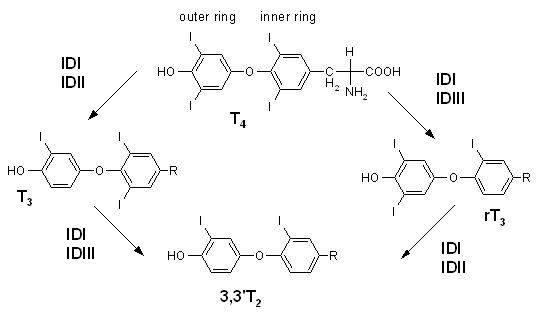Thyroxine
|
WikiDoc Resources for Thyroxine |
|
Articles |
|---|
|
Most recent articles on Thyroxine |
|
Media |
|
Evidence Based Medicine |
|
Clinical Trials |
|
Ongoing Trials on Thyroxine at Clinical Trials.gov Clinical Trials on Thyroxine at Google
|
|
Guidelines / Policies / Govt |
|
US National Guidelines Clearinghouse on Thyroxine
|
|
Books |
|
News |
|
Commentary |
|
Definitions |
|
Patient Resources / Community |
|
Patient resources on Thyroxine Discussion groups on Thyroxine Directions to Hospitals Treating Thyroxine Risk calculators and risk factors for Thyroxine
|
|
Healthcare Provider Resources |
|
Causes & Risk Factors for Thyroxine |
|
Continuing Medical Education (CME) |
|
International |
|
|
|
Business |
|
Experimental / Informatics |
Editor-In-Chief: C. Michael Gibson, M.S., M.D. [1]
Overview
Thyroxine, or 3:5,3':5' tetraiodothyronine (often abbreviated as T4) is the major hormone secreted by the follicular cells of the thyroid gland.
T4 is transported in blood, with 99.95% of the secreted T4 being protein bound, principally to thyroxine binding globulin (TBG) and to a lesser extent to transthyretin and serum albumin.
T4 is involved in controlling the rate of metabolic processes in the body and influencing physical development.
Note: Thyroxine is a prohormone and a reservoir for the active thyroid hormone triiodothyronine (T3), T4 being converted as required in the tissues by deiodinases.
Type II deiodinase converts T4 into T3.
The "D" isomer is called "Dextrothyroxine"[1] and is used as a lipid modifying agent.[2]
The half life of thyroxine once released into the blood circulatory system is about 1 week
Reactions

References
- ↑ Dextrothyroxine at the US National Library of Medicine Medical Subject Headings (MeSH)
- ↑ C10AX01 (WHO)